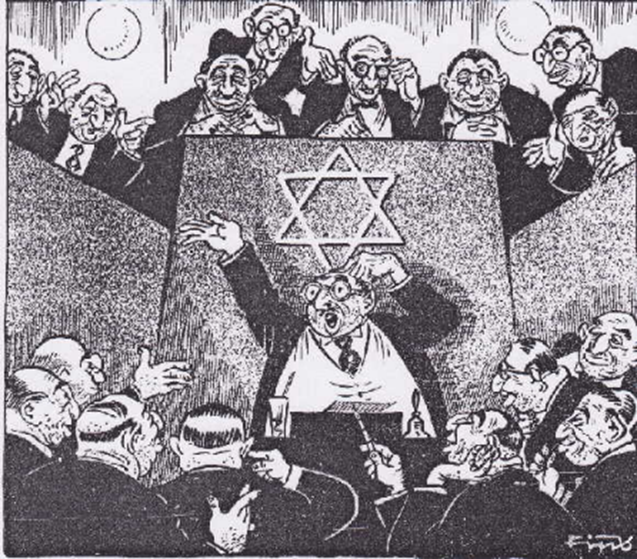Antisemitism: A History
Twentieth Century: The Rise of Nazism and the Holocaust
The following section will examine how the Nazis repackaged historical antisemitic tropes and capitalized on established European antisemitism, both latent and overt.
Adolf Hitler drew inspiration from prominent German and Austrian antisemites, as well as the growing populism and xenophobia of the völkisch movement of the nineteenth century. The Bolshevik Revolution in Russia provided Hitler with two scapegoats, Jews and communism. The Nazi Party promoted a close association between the two, which Hitler ultimately used to cement his grip on power in 1933.
German President Paul von Hindenburg named Hitler Germany’s chancellor on January 30, 1933. Though the Nazi Party had lost several seats in the November 1932 parliamentary elections, Hindenburg named Hitler chancellor after a series of political deals, raising the alarm of American Jewish leaders concerned about their coreligionists in Germany. Stephen Kinzer, “Hitler’s Rise Recalled With Sorrow,” New York Times, January 31, 1993, https://www.nytimes.com/1993/01/31/world/hitler-s-rise-recalled-with-sorrow.html?auth=login-email&login=email;
“Rabbis Fear Hitler as Enemy of Jews,” New York Times, February 6, 1933, https://timesmachine.nytimes.com/timesmachine/1933/02/06/99209692.pdf. On February 27, 1933, the Reichstag burned down. Nazi Party members in the government blamed communists and spread the false rumor that it was the beginning of a communist revolution in Germany. At the urging of the Nazis, the government passed the Reichstag Fire Decree, which limited the press and public assembly, the start of an attack on German civil liberties that the Nazi Party would continue once in power.
Hitler began to impose restrictions on Jews as early as 1933. That year, he restricted Jews from holding public office and the civil service. He barred Jews from farming and working in media. And the citizenship of naturalized Jewish immigrants was revoked. Then, on September 13, 1935, Hitler further fully legalized Jewish persecution with the Nuremberg Race Laws, which excluded Jews from marrying or having sexual relations with pure Germans and rescinded all Jews’ citizenship in Germany. The Nuremberg Laws also redefined who was a Jew. Under Jewish law, a Jew must be born of a Jewish mother. The Nuremberg Laws defined anyone with three of four Jewish grandparents as a Jew, entrapping many secular and assimilated German Jews and their descendants who had previously served faithfully in the German army. Greg Bradsher, “The Nuremberg Laws—Archives Receives Original Nazi Documents That ‘Legalized’ Persecution of Jews,” U.S. National Archives, Winter 2010, https://www.archives.gov/publications/prologue/2010/winter/nuremberg.html;
“Nuremberg Race Laws,” U.S. Holocaust Memorial Museum Holocaust Encyclopedia, accessed May 7, 2020, https://encyclopedia.ushmm.org/content/en/article/nuremberg-laws.
Nazi propaganda took advantage of a history of German antisemitism. In 1921, German historian Eduard Fuchs published Die Juden in der Karikatur: Ein Beitrag zur Kulturgeschichte (“The Jews in Caricature: A Contribution to Cultural History”), a comprehensive collection of Jewish caricatures from the fifteenth to twentieth centuries. Such caricatures were prominent in Nazi propaganda during the Holocaust. For example, a 1933 issue of the Nazi propaganda magazine Der Stürmer, entitled “Jewish Congress,” featured a caption that read: “Let the Goyim believe that we can be Americans, Englishmen, Germans, or French. When our interests are at stake, we are always Jews, and nothing but.”
The Holocaust was unique in history because of its industrialization of genocide. But Hitler’s tactics leading to the concentration camps relied on historical precedent. As previously noted, German Jews were largely assimilated into German culture. They served in the German army and in politics. Some even belonged to the Nazi Party early on. But after Hitler rose to power in 1933, he began to impose restrictions not just on Jewish religious life but on all of Germany’s Jews. At the opening of the Nuremberg Trials in 1945, U.S. Supreme Court Justice Robert H. Jackson remarked, “The most serious actions against Jews were outside of any law, but the law itself was employed to some extent. They were the infamous Nuremberg decrees of September 15, 1935.” Greg Bradsher, “The Nuremberg Laws—Archives Receives Original Nazi Documents That ‘Legalized’ Persecution of Jews,” U.S. National Archives, Winter 2010, https://www.archives.gov/publications/prologue/2010/winter/nuremberg.html.
Three years after the passage of the Nuremberg Laws, the violent pogroms of Russia arrived in Germany with the blessings of the Nazi regime. On November 7, 1938, a 17-year-old Polish Jew named Herschel Grynszpan shot and killed German official Ernst vom Rath. Grynszpan was reportedly upset about his family’s deportation from Germany. Two days later, on November 9, anti-Jewish riots broke out across Germany, Austria, and Czechoslovakia. The mobs destroyed synagogues, ransacked Jewish businesses and schools, and murdered 91 Jews over the course of 48 hours. The Nazi regime did nothing to stop the attacks and blamed them on a thirst for revenge against vom Rath’s assassination. “Kristallnacht,” U.S. Holocaust Memorial Museum, accessed October 3, 2019, https://www.ushmm.org/collections/bibliography/kristallnacht. The two-day event is today commemorated as Kristallnacht, the Night of Broken Glass. Ketzel Levine, “75 Years Ago, Kristallnacht Presaged The Holocaust,” NPR, November 9, 2013, https://www.npr.org/2013/11/09/244204135/75-years-ago-kristallnacht-presaged-the-holocaust.
Stay up to date on our latest news.
Get the latest news on extremism and counter-extremism delivered to your inbox.
